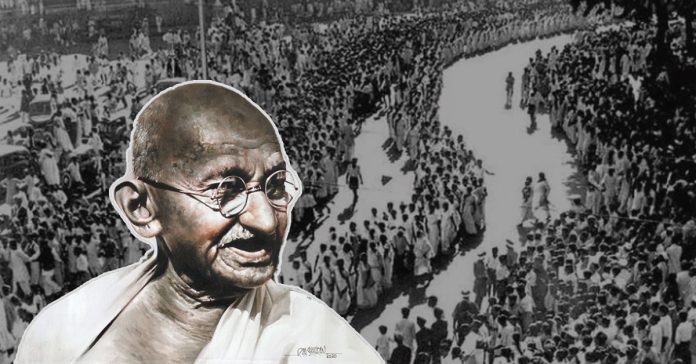Today 8th August 2022, marks 80years of Quit India Movement. We at Avaaz24, shall recollect our memories of this August Movement which gave British the final push towards independence.
What led to Quit India Movement?
1) The then Viceroy of India, Lord Linlithgow declared India alongside Britain against Hitler’s Germany in World War II. He didn’t took the opinion of Indian leaders.
2) In March 1942, Sir Stafford Cripps made an attempt to secure India’s cooperation in World War II. He offered dominion status to India after the war, if Indians cooperated with them. But Congress demanded full independence. As a result, Cripps Mission failed to provide a constitutional remedy. Consequently, Congress called for mass civil disobedience movement.
3) Mahatma Gandhi believed that if British left India, Japan would not invade India.
4) The already on going revolutionary protests joined Quit India Movement.
How Quit India Movement started?
After the failure of Cripps Mission, Mahatma Gandhi framed a resolution calling for British withdrawal. He suggested a non-cooperation movement against Japanese invasion. Congress Working Committee at Wardha on July 14,1942 accepted the idea of the struggle.
Further, All India Congress Committee approved Quit India resolution in August at Bombay. Finally, it was ratified at Gowalia Tank, Bombay on August 8, 1942. The resolution called for complete withdrawal of British power from India. Gandhi became the leader of the struggle. Jawaharlal Nehru, Sardar Vallabhbhai Patel, Maulana Azad, Chakravarti Rajagopalachari, Rajendra Prasad, Jayaprakash Narayan were other prominent leaders.
“There is a mantra a short one that I give you. You imprint it in your heart and let every breath of yours give an expression to it. The mantra is Do or Die. We shall either be free or die in the attempt”- said Gandhi.
“Quit India” or “Bharath Chodo”, “Do or Die” became the battle cries for every Indian during the movement.
What was British response?
In early hours of August 9, 1942, all the top leaders of the congress were arrested. Their destinations were unknown.
Under the Criminal Law Amendment Act of 1908, all Congress Working Committees were declared unlawful associations.
Under rule 56 of Defence of India rules, assembly public meetings was not possible. Government imposed restrictions on publications of news.
Even though, all established leaders were under arrest, the movement didn’t suppress. Young Aruna Asaf Ali, who was till then relatively unknown, presided over the remainder congress committee session. She hoisted the Congress flag at Gowalia Tank on August 9. She then announced the commencement of the movement. Hence, Aruna Asaf Ali is the Heroine of the Quit India Movement.
How Quit India Movement progressed?
The movement had 3 phases. First phase involved urban revolts, strikes and boycotts. The second phase witnessed major peasant rebellions and destruction of government assets. In the third phase parallel governments stood in isolated pockets of the country.
By the end of 1942, about 60,000 people were put in jail. Hundreds of people were killed.
When Quit India Movement ended?
The movement got greatly suppressed by 1944. Gandhi was released from jail. War in Europe came to end in 1945. Prime Minister of Britain Winston Churchill wanted to reach a constitutional remedy with India. Following this, Viceroy Lord Wavell started negotiations with Indian leaders. Congress leaders came out of jails in June 1945.
Quit India Movement in Andhra (Madras Province):
Quit India Movement spread to all the states and provinces across the country. In Andhra, on 29th July 1942, Kala Venkat Rao a member of Provincial Congress Committee drafted ‘Kurnool Circular’. Then, Pattabhi Sitaramaiah took the draft to the Congress Working Committee for approval.
Kurnool Circular proposed to oppose all prohibitory orders. It meant to paralyse all means of communication. Further, it proposed damaging all machinery of the administration. Some prominent leaders of this Movement in Andhra were- Pattabhi Sitaramaiah, A. Kaleshwer Rao, Tanguturi Prakasham, Neelam Sanjeeva Reddy etc.
Quit India Movement in Hyderabad State:
Nizams were faithful allies of British. So, they did not allow anything that would upset the British. Even then, Hyderabad Congress took up Gandhi’s call.
Swamy Ramananda Tirtha met Mahatma Gandhi at Bombay session. He got the permission to conduct Quit India Movement in Hyderabad state. Not only State Congress, but various Praja Mandals also participated in the Quit India struggle.
Incidentally, some reactionary elements in Hyderabad took advantage of the slogan of Quit India. They said, the British withdrawal from India would automatically mean the independence of Hyderabad. Consequently, they raised the slogan “Azad Hyderabad”.
Prominent leaders of this movement from Hyderabad State are- Ravi Narayan Reddy, Vinayak Rao Vidyalankar, Pandit Narenderji, Abid Hasan Safrani, Fatauallh Khan, Hanumanth Rao etc.
Quit India Movement: Success or Failure?
Undoubtedly, Quit India Movement united Indian people against British rule. The movement failed to achieve India’s independence immediately. But, Britain understood that the demand for freedom could no longer be ignored. The movement was the final push. The war-weary Britain finally gave in. As a result, we got independence in 1947.


